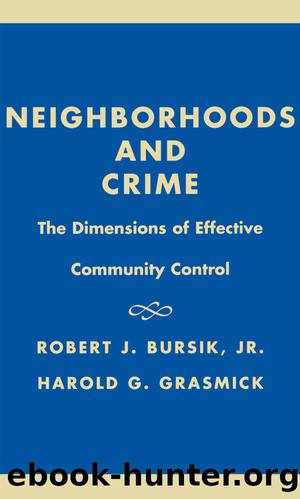Neighborhoods and Crime by Bursik Robert J. Jr.;Grasmick Harold G.;Bursik;Grasmick;Grasmick; & Harold G. Grasmick

Author:Bursik, Robert J., Jr.;Grasmick, Harold G.;Bursik;Grasmick;Grasmick; & Harold G. Grasmick
Language: eng
Format: epub
Publisher: Lexington Books/Fortress Academic
Published: 1993-08-15T00:00:00+00:00
Crime and Delinquency as Group Phenomena
There are very few issues concerning which criminologists usually feel confident enough to make strong declarative statements. However, the group nature of delinquency is certainly one of those issues. One of the most influential findings of the Shaw and McKay research was that almost 90 percent of the delinquent events reflected in the juvenile court records of Cook County involved two or more participants (Shaw et al. 1929:7â8). The group orientation was strongly reinforced several years later when Edwin Sutherland (1934) began to develop his influential theory of differential association, which emphasized the small-group dynamics associated with the learning of delinquent and criminal behavior. More recent work has noted some important offense-specific differences in the rates of group offending. In addition, a large proportion of offenders do not engage in illegal behavior strictly in group situations (see the review of Reiss 1988). Nevertheless, the presumed group nature of illegal behavior is a generally uncontested part of criminological lore.
There have been several important criticisms of the group hypothesis. The differential association perspective suggests that the most important sources of information concerning the techniques, motivations, and justifications for illegal behavior are intimate personal groups (see Sutherlandâs propositions 3 and 4). Given the apparent group nature of crime and delinquency, the intimate nature of these groups might suggest that offenses occur primarily within aggregations with temporal histories, fairly developed sets of relationships among the members, and relatively high levels of cohesiveness and solidarity. However, Klein (1969) has argued that the existence of two or more offenders in a single incident does not in itself guarantee that the event represents the outcome of such group dynamics. He criticizes in particular the influence that the Shaw and McKay findings have had on the discipline, for they were based on official records in which it is impossible to determine the actual group dynamics that may have been involved.
Klein illustrates this problem with several hypothetical examples, including one in which a relatively large number of strangers are attending a party and they happen to purchase marijuana from one of the other attendees. If the police happen to bust the party and make multiple arrests for possession, the arrest reports would most likely note that several people were involved in the incident. However, they would not constitute a group in any sociological sense of the word. Rather, these people were simply âcontiguous individualsâ (Klein 1969:67) who were engaged in the same behavior in the same location. Because of such conceptual ambiguities, some researchers now utilize alternative phrases (such as âco-offendingâ; Reiss 1988) to refer to events in which more than one person was involved but in which the existence of group dynamics is not clear.5
Klein certainly is not arguing that group dynamics are unrelated to criminal and delinquency behavior. Rather, he is emphasizing the need to recognize the basic distinction between the sociological notions of aggregate and group processes. In that respect, some unknown percentage of illegal behavior may be more validly viewed
Download
This site does not store any files on its server. We only index and link to content provided by other sites. Please contact the content providers to delete copyright contents if any and email us, we'll remove relevant links or contents immediately.
Cecilia; Or, Memoirs of an Heiress — Volume 1 by Fanny Burney(32036)
Cecilia; Or, Memoirs of an Heiress — Volume 3 by Fanny Burney(31444)
Cecilia; Or, Memoirs of an Heiress — Volume 2 by Fanny Burney(31392)
The Great Music City by Andrea Baker(30765)
We're Going to Need More Wine by Gabrielle Union(18617)
All the Missing Girls by Megan Miranda(14648)
Pimp by Iceberg Slim(13764)
Bombshells: Glamour Girls of a Lifetime by Sullivan Steve(13673)
Fifty Shades Freed by E L James(12895)
Talking to Strangers by Malcolm Gladwell(12841)
Norse Mythology by Gaiman Neil(12802)
For the Love of Europe by Rick Steves(11350)
Crazy Rich Asians by Kevin Kwan(8873)
Mindhunter: Inside the FBI's Elite Serial Crime Unit by John E. Douglas & Mark Olshaker(8678)
The Lost Art of Listening by Michael P. Nichols(7147)
Enlightenment Now: The Case for Reason, Science, Humanism, and Progress by Steven Pinker(6860)
The Four Agreements by Don Miguel Ruiz(6300)
Bad Blood by John Carreyrou(6265)
Weapons of Math Destruction by Cathy O'Neil(5809)
